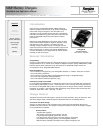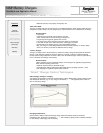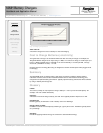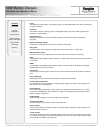
Charger Handbook
Version: Chg1.4
Energizer Battery Manufacturing Inc. | 800-383-7323 (USA-CAN) | www.energizer.com
©2008 Energizer – Contents herein does not constitute a warranty of service, features or performance Page 4 of 4
NiMH Battery Chargers
Handbook and Application Manual
Cycle:
The discharge and subsequent or proceeding charge of a rechargeable battery such that it is restored to
its original conditions.
Cycle Life:
The number of charge / discharge cycles a rechargeable battery can perform before capacity drops
below 60% of rated capacity.
Deep Discharge:
Discharge of the battery to below the specified voltage cutoff before the battery is replaced or
recharged.
Depth of Discharge (DOD):
The percent of rated capacity to which a cell or battery is discharged.
Duty Cycle:
The time duration and use frequency during which a battery is drained (i.e. 2 hours/day).
Milliamp-Hours (mAh):
Product of current (mA), multiplied by time (in hours) the circuit is closed (current flowing).
NiCd:
A rechargeable Nickel Cadmium battery chemistry. In which nickel material is the cathode and cadmium
is the Anode.
NiMH:
A rechargeable Nickel-Metal Hydride battery chemistry. In which Nickel is the cathode and hydrogen
absorbing/storing material is the anode.
Overcharge:
The forcing of current through a cell after all of the active material has been converted to the charged
state.
Over-discharged:
Discharge past the point where the full capacity of the cell has been obtained.
Primary Battery Detection:
Primary batteries are not designed to be recharged. Many chargers can detect a primary battery and
then terminate the charging process.
Rated Capacity:
The average capacity delivered by a cell or battery on a specified load and temperature to a voltage
cutoff point, as designated by the manufacturer; usually an accelerated test approximating the cell or
battery’s capacity in typical use.
Rechargeable:
Capable of being recharged; refers to secondary cells or batteries.
Self Discharge Rate:
The rate at which a cell or battery loses its charge when idle.
Smart Charger:
A charger that monitors the batteries condition and automatically terminates the main charge when it
senses the battery is near full.
Trickle Charge:
A method of recharging in which a secondary battery is either continuously or intermittently connected
to a constant current supply that maintains the battery in a fully or near full charged condition. Typical
trickle charges are between 0.03C and 0.05C.
Contents
Introduction
General
Information
Charge Control
“Smart” Charger
Control Techniques
Cost to Charge
(electricity)
Summary
Glossary






